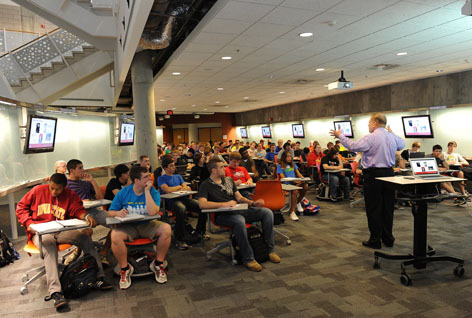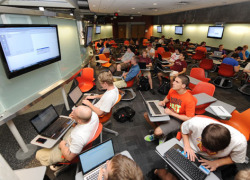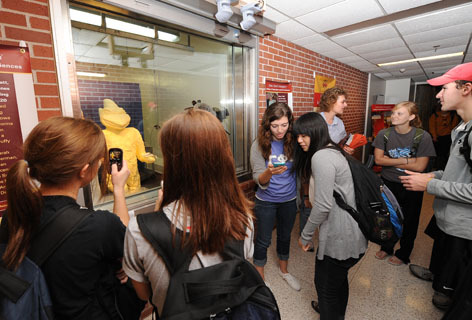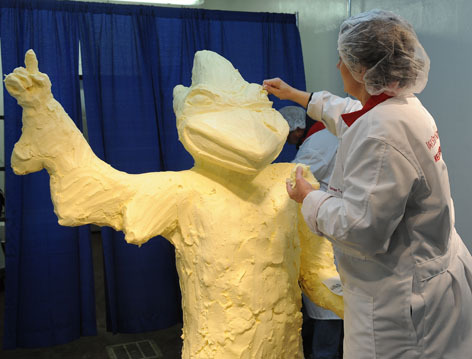Howe classroom is one of a kind

Professor Richard Wlezien utilized the room's 12 monitors for a lecture presentation for his Aerospace 160 class on Wednesday. Photo by Bob Elbert.
An area that once served as a popular napping spot in Howe Hall now boasts one of the most innovative teaching spaces on campus. An estimated 2,260 square feet of atrium lounge space has been converted into a "next generation interactive classroom."
The concept originated with Richard Wlezien, professor and chair of the aerospace engineering department; and Tom Brumm, associate professor in agriculture and biosystems engineering and professor-in-charge of online learning for the colleges of Engineering and Liberal Arts and Sciences.
"It's a one-of-a-kind classroom. You're not going to go anywhere else and see a classroom like this," Wlezien said. "We're going out of our way to be a nonconventional engineering classroom."

Students are able to arrange seating and utilize individual monitors for group projects. Photo by Bob Elbert.
The new open-air classroom facilitates interactive breakout groups and instructor lectures. However, don't expect a typical "head-of-the-class" setup. Rolling chairs (in assorted, non-uniform colors) with ambidextrous desk attachments make group work or lecture setups easy. Custom glass-topped whiteboards line both sides of the space, and 12 video monitors are dispersed lengthwise along the whiteboards. A drop-down screen, projector and wireless microphone system also are built in.
Students can work in teams, plugging individual computers into their own video monitors. Or, Wlezien can broadcast his multimedia presentation on all of the screens simultaneously from his iPad as he circulates through the classroom.
Test run
A former NASA program director, Wlezien teaches two sections of Aerospace 160 -- an introductory course. When he arrived on campus two years ago, he wanted to create a space for his class of 120 students that didn't require booking a room across campus.
Wlezien took over the atrium lounge space and taught the course to students in folding chairs. Despite the undefined classroom space, he said the setup encouraged more participation and improved the retention rate of the course.
"The students got so used to working out in the open, that they actually preferred it," he said. "They seemed to learn better when there was a more open environment."
Strategic funds
Other projects
Facilities planning and management also is working on "active learning" classrooms in 2104 Gilman Hall and 213 MacKay Hall. The rooms feature similar rolling chairs, multiple whiteboards and upgraded electronics.
The class was such a success that the Engineering college, aerospace department and college online learning office partnered with the provost's office to utilize FY12 strategic initiative project funds to convert the space permanently. Des Moines-based Smith Metzger architect firm was charged with creating a unique space, partnering with staff from ISU facilities planning and management's project and construction management team to make it a reality.
"We didn't want a conventional classroom," Wlezien said. "We wanted to inspire creativity. We also wanted to inspire teamwork."
The finishing touches were put on the $250,000 project this week, and Wlezien moved his classes from the atrium lobby to the finished space on Oct. 22. He said demand for the classroom already is growing, and it might also be used for visitor presentations.
"Our hope is that if this works as well as we think it will, it's going to be mimicked in other places on campus," Wlezien said. "You can convert an open area into something very unique."
Changes to budget model won't affect FY14 budgets
The process of implementing changes to the university's 5-year-old budget model is under way, but no changes will be made this year that affect budgets for the fiscal year that begins next July.
Last month, president Steven Leath appointed a work group to review each of the 47 recommendations presented in a May 2012 report (PDF) by the group that completed a 10-month review of the Resource Management Model (RMM). (These 47 recommendations were amassed in the report's Appendix D, pp. 106-113.) In August, Leath addressed one of the review committee’s recommendations by calling for changes to the budget advisory committee structures.
The work group will be lead by the president's office and includes these members:
- Dave Biedenbach, assistant vice president for financial planning and budgets, president's office
- Pam Elliott Cain, associate vice president for business and finance
- Kathy Jones, associate vice president for student affairs
- Miles Lackey, associate vice president and chief of staff, president's office
- Ellen Rasmussen, associate vice president for budget and planning, provost's office
By early November, the group hopes to complete an initial review of the 47 recommendations and develop an implementation plan. The plan will provide:
- Changes that will be made during the FY14 budget development process (changes in this category will not impact units’ FY14 budgets)
- Recommended changes that need further input from subject experts on campus (implementation of changes most likely would occur after FY14)
- Proposed alternatives to an issue addressed by the review committee. The work group would seek campus input on the proposed alternatives.
Biedenbach said the group hopes to share a preliminary implementation plan with Leath by early December. Implementing changes would occur over several fiscal years, he said.
"We don't have a timeline for implementing all of the changes that will be made. The important thing is that we implement changes that address the issues that were highlighted during the formal review process," Biedenbach said. Units should proceed with FY14 budget planning with the assurance that any changes made to the model this year "won't have a dollar impact on units' FY14 budgets."
Despite the fact that the RMM review committee sought and received extensive campus input both to prepare its draft report and before it completed its final report, Biedenbach said the implementation group would not hesitate to ask for more input.
Background
Iowa State units first used the RMM to build budgets for the fiscal year that ended June 30, 2009. The model is designed to link resources with responsibilities, offer better flexibility as priorities evolve, and build in incentives to support university goals and strategies. The committee that adapted and led its implementation recommended a review of the model after three to five years of use. The review committee began its work in June 2011.
Questions about the implementation process for RMM changes may be directed to Biedenbach.
ISU Plan open change period begins Nov. 1
Faculty, professional and scientific staff, and supervisory merit employees may review and change their ISU Plan benefits during the annual open change period, Nov. 1-16.
What's new for 2013?
Medical premiums for both the PPO and HMO plans have little or no increases for 2013.
|
Monthly medical premium: Cost to employees |
||||
|---|---|---|---|---|
|
|
PPO |
HMO |
||
|
|
2012 |
2013 |
2012 |
2013 |
|
You only |
$19 |
$20 |
$0 |
$0 |
|
You + spouse |
$263 |
$263 |
$78 |
$78 |
|
You + children |
$173 |
$173 |
$45 |
$46 |
|
You + family |
$325 |
$335 |
$108 |
$111 |
|
Family -- double spouse |
$95 |
$96 |
$0 |
$0 |
Dental changes
Costs for both the basic and comprehensive dental plans remain the same for 2013. However, there is a new addition to the basic plan called CheckUp Plus, which encourages regular dental visits for better overall health. Employees who choose the basic dental plan (as well as those already enrolled in it) automatically will receive CheckUp Plus. For no additional cost, CheckUp Plus waives diagnostic and preventive dental service costs from the annual maximum amount. Here's how it works:
|
Basic ISU Plan benefits with CheckUp Plus |
||
|---|---|---|
|
Example: Two routine checkups (two exams, routine X-rays, two cleanings) covered 100 percent with $750 annual maximum |
||
|
Delta Dental pays |
Member pays |
Annual maximum remaining |
|
$350 |
$0 |
$750* |
*Without CheckUp Plus, the annual maximum remaining would be $400
Mark your calendar
- Nov. 1: Open change period begins at 8 a.m.; participation statements available on AccessPlus
- Nov. 8: Live webcast, 9-10 a.m. (archived replay will be available on the benefits website)
- Nov. 16: Open change period ends at 5 p.m.
- Nov. 30: Benefit confirmation statements available on AccessPlus (beginning at 8 a.m.)
- Dec. 7: Final day to report errors on benefit confirmation statements (before 5 p.m.)
- Jan. 11, 2013: Final benefit statements of 2013 elections available on AccessPlus
Flexible spending limit is reduced
The health care flexible spending account limit will decrease from $5,000 to $2,500 per account for 2013. The change is part of the Affordable Care Act. A list of eligible claims for flexible spending accounts is available on the ASIFlex website.
Reminders
Employees may continue to insure children up to age 26 on their medical, dental, dependent life and Avesis vision plans for 2013. To qualify, children must be under age 26 on Jan. 1, 2013. Children may be covered even if they are married or have a job with health care benefits. If children already have benefits, the ISU coverage would supplement their primary health plans.
If children turn 26 in 2013, coverage must end Dec. 31, 2013. However, if children are unmarried and enroll as full-time students during the year, they can remain on their parents' ISU health, dental and vision plans until they either get married or stop being full-time students. Remember, there may be tax implications for employees who insure students over age 26.
Non-supervisory merit employees may make changes to their 2013 benefits through 5 p.m. Nov. 16.
How to change your benefits
ISU Plan participants may alter their medical, dental, flexible spending and Avesis coverage online through AccessPlus. Some changes may require paper forms, which are available on the benefits website or from human resource services (4-4800). If you are making no changes, there's no need to update your benefits; your current choices will carry over to 2013. The carryover exception is those with health care flex spending above the new maximum; higher amounts will be reduced to the maximum allowed.
More information
HRS is hosting an interactive webcast for ISU Plan employees Nov. 8 (9-10 a.m.). To participate, log on to http://connect.extension.iastate.edu/benefits. At the login page, enter your name under the "Enter as a Guest" heading, then click "Enter Room."
Proposal for tuition, mandatory fees freeze goes to regents
Tuition for resident undergraduates would not increase next year and mandatory fees for all Iowa State students would remain unchanged for a third year under a proposal going to the state Board of Regents this week. Graduate tuition for in-state students would go up $92 (1.2 percent). As proposed, out-of-state students would pay 2.35 percent more in tuition next year -- $440 for undergraduates and $462 for graduates.
The board meets Thursday in Iowa City, but won't make a final decision on 2013-14 tuition and fees until its Dec. 5 meeting. A live audio stream of all public portions of the meeting is online at the board's website.
Resident undergraduates are paying $6,648 in tuition and $1,078 in mandatory fees this year. That sum puts Iowa State in 11th place among its peer group of 11 this academic year.
Differential tuition
Differential tuition plans are exempted from the proposed tuition freeze. Iowa State is proposing differential tuition next year for four student groups: juniors and seniors in agricultural systems technology and industrial technology (both in the ag and biosystems engineering department), and undergraduate and graduate architecture students. Resident AST and ITec upper division students would pay an additional $584 (non-residents $1,052), the third of a revised four-year incremental increase to lower student-to-faculty ratios and provide excellent instruction and cutting-edge lab experiences. Adding a fourth year would align tuition for these programs with others in the College of Engineering.
All resident architecture students would pay a proposed $400 in additional tuition next year -- the second of a three-year plan -- intended to help hire more faculty to address the program's 30 percent enrollment increase since 2007. For out-of-state students, the increase is a proposed $850.
If the differential tuitions are approved, these students would join upper division ISU students in the colleges of Engineering and Business who have paid differential tuition since 2006 and 2009, respectively.
Frederiksen Court expansion
The residence department will ask the board to approve its schematic design and budget ($30.9 million) to add six apartment buildings – housing a total of 720 students -- to the Frederiksen Court student community. Currently that neighborhood includes 23 apartment buildings. The residence department proposes to finance the project through two dormitory revenue bond sales (April 2013 and 2014).
The new buildings would be slightly larger versions of the existing buildings, with six more apartments per building and all single bedrooms.
If approved, site work could begin this winter. A phased timeline proposes that the buildings would be first occupied in the fall 2013 and spring and fall 2014 semesters.
Tuition set aside
The future of tuition set aside as a student financial aid strategy also is on the board's agenda. Last month, the board received a proposal to end the practice and replace it, in part, with a not-yet-in-existence state-funded student aid program that would assist only resident undergraduate students who demonstrate a financial need. The foundations affiliated with Iowa's three public universities also would be asked to conduct five-year campaigns to raise funds for merit-based and other scholarships, also targeting resident undergraduate students.
In other action, the board will consider Iowa State requests to:
- Enter a 10-year agreement with PUREnergy Partners to lease a small (100 kilowatts) wind turbine to be constructed east of the ISU power plant. The company would keep ownership of the turbine; Iowa State exclusively could purchase all of the output of the turbine, as well as have access to it for teaching, research or demonstrations.
- Award the title of president emeritus to former president Gregory Geoffroy in recognition of "his bold vision, strong leadership, valuable knowledge and experience, and tenure at Iowa State University which resulted in recruiting and retaining top faculty, staff and students; private fundraising to support faculty positions and student scholarships; and sustaining and advancing the state's position in the growing bioeconomy." Geoffroy served as Iowa State president from to July 2001 to January of this year.
- Revise the project budget for the School of Education office remodeling in Lagomarcino Hall (up $825,000, to $3.725 million). Construction changes include a new central north entrance/addition to the building, the addition of a fire sprinkler system in the areas being remodeled, and classrooms and office areas to replace those being displaced for the School of Education.
A historic homecoming celebration

A viewing window gives visitors a chance to watch -- and photograph -- the Butter Cy sculpting process. Photo by Bob Elbert.
Game time is set and the celebration is well under way to mark the 100th anniversary of homecoming at Iowa State. The Cyclones kick off against the Baylor Bears at 6 p.m. Saturday in Jack Trice Stadium for the marquee event.
After three days of work, sculptor Sarah Pratt's life-sized Butter Cy is on display on the ground floor of Kildee Hall (follow the signs), Yell Like Hell finalists are set and people who purchased homecoming buttons are enjoying free lunch on central campus all week. And there are plenty more Cytennial events left to enjoy.
2012 Cytennial Homecoming: "Taking Ames by Storm"
Homecoming online
(Events are free, unless indicated)
Thursday, Oct. 25
- 11 a.m.-1 p.m., Food on campus (pizza, carrots, ice cream, root beer), $5 or free with homecoming button
Friday, Oct. 26
- 8 a.m.-5 p.m., "100 Years of Homecoming" exhibit, 403 Parks Library
- 8 a.m.-5 p.m., Butter Cy display, Kildee Hall atrium (follow signs)
- 11 a.m.-1 p.m., Food on campus (pulled pork, corn, cookies), $5 or free with homecoming button
- 1:30 p.m., Honors and awards ceremony, Benton Auditorium, Scheman Building
-
5-9 p.m., Pep rally and centennial celebration, ISU Alumni Center (free pizza with homecoming button)
-- Pep rally begins at 7 p.m.
-- Activities include carnival games, giveaways, Yell Like Hell finals and Cardinal Court recognition - 8-10 p.m., "ExCYtement in the Streets" lawn displays, Greek neighborhood
- 8-10 p.m., Window lighting display ("100" and "ISU"), Maple, Larch, Wallace and Wilson residence halls
- 8 p.m., Brantley Gilbert "Hell on Wheels" concert, Hilton Coliseum ($30-37)
- 10 p.m.-1 a.m., Pancake feed, central campus ($3)
- Midnight, Mass campaniling and fireworks, central campus
Saturday, Oct. 27
- 7:30 a.m.-6 p.m., Butter Cy display, Kildee Hall
- 1-5:30 p.m., Cyclone Central tailgate, ISU Alumni Center
- 6 p.m., Football vs. Baylor, Jack Trice Stadium ($40-$65)
Sunday, Oct. 28
- 8-11 a.m., Homecoming breakfast, American Legion, 225 Main St. ($5)

